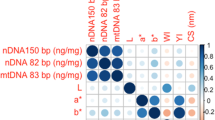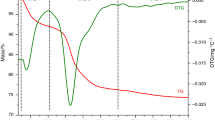Abstract
This study presents a novel tool to predict temperature-exposure of incinerated pig teeth as a proxy for understanding impacts of fire on human teeth. Previous studies on the estimation of temperature-exposure of skeletal elements have been limited to that of heat-exposed bone. This predictive tool was developed using a multinomial regression model of colourimetric and hydroxyapatite crystal size variables using data obtained from unheated pig teeth and teeth incinerated at 300 °C, 600 °C, 800 °C and 1000 °C. An additional variable based on the observed appearance of the tooth was included in the tool. This enables the tooth to be classified as definitely burnt (600 °C–1000 °C) or uncertain (27 °C/300 °C). As a result, the model predicting the temperature-exposure of the incinerated teeth had an accuracy of 95%. This tool is a holistic, robust and reliable approach to estimate temperature of heat-exposed pig teeth, with high accuracy, and may act as a valuable proxy to estimate heat exposure for human teeth in forensic casework.



Similar content being viewed by others
References
Symes SA et al (2015) Patterned thermal destruction in a forensic setting. In: Schmidt CW, Symes SA (eds) The Analysis of Burned Human Remains, 2nd edn. Academic Press, San Diego, pp 17–59
Ellingham STD, Thompson TJU, Islam M, Taylor G (2015) Estimating temperature exposure of burnt bone — a methodological review. Sci Justice 55(3):181–188
Ubelaker DH (2009) The forensic evaluation of burned skeletal remains: a synthesis. Forensic Sci Int 183(1-3):1–5
Bush MA, Bush PJ, Miller RG (2006) Detection and classification of composite resins in incinerated teeth for forensic purposes. J Forensic Sci 51(3):636–642
Rahmat RA et al (2020) Integrating spectrophotometric and XRD analyses in the investigation of burned dental remains. Forensic Sci Int 310:110–236
Höss M et al (1996) DNA damage and DNA sequence retrieval from ancient tissues. Nucleic Acids Res 24(7):1304–1307
Higgins D, Austin JJ (2013) Teeth as a source of DNA for forensic identification of human remains: a review. Sci Justice 53(4):433–441
Shipman P, Foster G, Schoeninger M (1984) Burnt bones and teeth: an experimental study of color, morphology, crystal structure and shrinkage. J Archaeol Sci 11(4):307–325
Schmidt CW (2015) Burned human teeth. In: Schmidt CW, Symes SA (eds) The Analysis of Burned Human Remains, 2nd edn. Academic Press, San Diego, pp 61–81
Mayne-Correia PM (1996) Fire modification of bone: a review of the literature. In: Haglund WD, Sorg MH (eds) Forensic Taphonomy : the Postmortem Fate of Human Remains. CRC Press, Boca Raton, pp 275–286
Devlin JB, Herrmann NP (2008) Bone color as an interpretive tool of the depositional history of archaeological cremains. In: Schmidt CW, Symes SA (eds) The Analysis of Burned Human Remains. Academic Press, San Diego, p 109-x
Rubio L et al (2015) Spectrophotometric analysis of color changes in teeth incinerated at increasing temperatures. Forensic Sci Int 252:193.e1–193.e6
Krap T, Nota K, Wilk LS, van de Goot FRW, Ruijter JM, Duijst W, Oostra RJ (2017) Luminescence of thermally altered human skeletal remains. Int J Legal Med 131(4):1165–1177
Greiner M, Rodríguez-Navarro A, Heinig MF, Mayer K, Kocsis B, Göhring A, Toncala A, Grupe G, Schmahl WW (2019) Bone incineration: an experimental study on mineral structure, colour and crystalline state. J Archaeol Sci-Rep 25:507–518
Wärmländer SKTS et al (2018) Estimating the temperature of heat-exposed bone via machine learning analysis of SCI color values: a pilot study. J Forensic Sci 51(1)
Bonucci E, Graziani G (1975) Comparative thermogravimetric, X-ray diffraction and electron microscope investigations of burnt bones from recent, ancient and prehistoric age. Atti della Accademia Nazionale dei Lincei. Classe di Scienze Fisiche, Matematiche e Naturali. Rendiconti 59(5):517–532
Sandholzer M (2015) Influence of heating regimes on dimensional and colorimetric changes of teeth. In: Schmidt CW, Symes SA (eds) The Analysis of Burned Human Remains, 2nd edn. Academic Press, San Diego, pp 365–379
Karkhanis S, Ball J, Franklin D (2009) Macroscopic and microscopic changes in incinerated deciduous teeth. J Foren odonto-stomatol 27(2):9–19
Garriga JA, Ubelaker DH, Zapico SC (2016) Evaluation of macroscopic changes and the efficiency of DNA profiling from burnt teeth. Sci Justice 56:437–442
Quatrehomme G et al (1998) Experimental single controlled study of burned bones: contribution of scanning electron microscopy. J Forensic Sci 43(2):417–422
de Becdelievre C, Thiol S, Santos F, Rottier S (2015) From fire-induced alterations on human bones to the original circumstances of the fire: an integrated approach of human cremains drawn from a Neolithic collective burial. J Archaeol Sci Rep 4:210–225
Sandholzer, M., Heat-induced alterations of dental tissues. 2014, ProQuest Dissertations Publishing.
Krap T, van de Goot FRW, Oostra RJ, Duijst W, Waters-Rist AL (2017) Temperature estimations of heated bone: a questionnaire-based study of accuracy and precision of interpretation of bone colour by forensic and physical anthropologists. Legal Med 29:22–28
Goodman TM (2012) International standards for colour, in Colour Design : Theories and Applications. In: Best J, Staff TI (eds) . Elsevier Science & Technology, Cambridge, pp 177–218
(1977)CIE recommendations on uniform color spaces, color-difference equations, and metric color terms. Color Res Appl 2(1): 5-6.
Etok SE, Valsami-Jones E, Wess TJ, Hiller JC, Maxwell CA, Rogers KD, Manning DAC, White ML, Lopez-Capel E, Collins MJ, Buckley M, Penkman KEH, Woodgate SL (2007) Structural and chemical changes of thermally treated bone apatite. J Mater Sci 42(23):9807–9816
Elliott JC (1994) Structure and chemistry of the apatites and other calcium orthophosphates. In: Studies in inorganic chemistry, vol 18. Elsevier, Amsterdam, p 389
Piga G, Thompson TJU, Malgosa A, Enzo S (2009) The potential of X-ray diffraction in the analysis of burned remains from forensic contexts. J Forensic Sci 54(3):534–539
Figueiredo M, Fernando A, Martins G, Freitas J, Judas F, Figueiredo H (2010) Effect of the calcination temperature on the composition and microstructure of hydroxyapatite derived from human and animal bone. Ceram Int 36(8):2383–2393
Galeano S, García-Lorenzo ML (2014) Bone mineral change during experimental calcination: an x-ray diffraction study. J Forensic Sci 59(6):1602–1606
Piga G et al (2016) Understanding the crystallinity indices behavior of burned bones and teeth by ATR-IR and XRD in the presence of bioapatite mixed with other phosphate and carbonate phases. Int J Spectrosc 2016:9
Rees KA, Cox MJ (2010) Comparative analysis of the effects of heat on the PCR-amplification of various sized DNA fragments extracted from Sus Scrofa molars. J Forensic Sci 55(2):410–417
Berketa J, James H, Langlois N, Richards L (2015) The use of incinerated pig head in dental identification simulation. J Forensic Odontostomatol 33(2):1–8
Robinson C, Kirkham J, Weatherell JA, Richards A, Josephsen K, Fejerskov O (1988) Mineral and protein concentrations in enamel of the developing permanent porcine dentition. Caries Res 22(6):321–326
Piga G, Solinas G, Thompson TJU, Brunetti A, Malgosa A, Enzo S (2013) Is X-ray diffraction able to distinguish between animal and human bones? J Archaeol Sci 40(1):778–785
Doebelin N, Kleeberg R (2015) Profex: a graphical user interface for the Rietveld refinement program BGMN. J Appl Crystallogr 48(Pt 5):1573–1580
Doebelin N (2018) Profex user manual version 3.14. 2018. 144.
Bergmann J, Taut T (2005) Manual: Rietveld Analysis Program BGMN®. 130.
Team, R.C (2013) R: A language and environment for statistical computing. R Foundation for Statistical Computing, Vienna
Chang W, et al. (2019) Shiny: Web Application Framework for R.
Beach JJ, Passalacqua NV, Chapman EN (2008) Heat-related changes in tooth color: temperature versus duration of exposure. In: Schmidt CW, Symes SA (eds) The Analysis of Burned Human Remains. Academic Press, San Diego, pp 137–1xi
Buikstra JE, Swegle M (1989) Bone modification due to burning: experimental evidence. Bone modificat:247–258
Fairgrieve SI (1994) SEM analysis of incinerated teeth as an aid to positive identification. J Forensic Sci 39(2):557–565
Harsanyi L (1975) Scanning electron microscopic investigation of thermal damage of the teeth. Acta Morphol Acad Sci Hung 23(4):271–281
Campbell MN, Fairgrieve SI (2011) Differentiation of traumatic and heat-induced dental tissue fractures via SEM analysis*. J Forensic Sci 56(3):715–719
Burki Z, Watkins S, Wilson R, Fenlon M (2013) A randomised controlled trial to investigate the effects of dehydration on tooth colour. J Dent 41(3):250–257
ten Bosch JJ, Coops JC (1995) Tooth color and reflectance as related to light scattering and enamel hardness. J Dent Res 74(1):374–380
ASTM (2015) Standard practice for calculating yellowness and whiteness indices from instrumentally measured color coordinates. ASTM International USA.
Baby RS (1954) Hopewell cremation practices. Ohio Historical Society.
Ortiz-Ruiz AJ, Teruel-Fernández JD, Alcolea-Rubio LA, Hernández-Fernández A, Martínez-Beneyto Y, Gispert-Guirado F (2018) Structural differences in enamel and dentin in human, bovine, porcine, and ovine teeth. Ann Anat Anatomischer Anzeiger 218:7–17
Acknowledgements
A sincere gratitude to Professor Robert Fitzpatrick from the Acid Sulfate Soils Centre (ASSC)|Centre for Australian Forensic Soil Science (CAFSS). The University of Adelaide for providing expertise, facility and equipment at Water and Land division, CSIRO, Waite, South Australia. RR would like to give a special thanks to Mr. Anthony Wilkes from the School of Animal and Veterinary Sciences, the University of Adelaide, for preparing the samples.
Funding
This work was financially supported by the School of Biological Sciences, the University of Adelaide.
Author information
Authors and Affiliations
Corresponding author
Ethics declarations
Ethical standards
The handling of the animal remains in this study was conducted according to the University of Adelaide Animal Ethics.
Conflicts of interest
The authors declare no competing interests.
Additional information
Publisher’s note
Springer Nature remains neutral with regard to jurisdictional claims in published maps and institutional affiliations.
Rights and permissions
About this article
Cite this article
Rahmat, R.A., Humphries, M.A., Austin, J.J. et al. The development of a tool to predict temperature-exposure of incinerated teeth using colourimetric and hydroxyapatite crystal size data. Int J Legal Med 135, 2045–2053 (2021). https://doi.org/10.1007/s00414-021-02538-7
Received:
Accepted:
Published:
Issue Date:
DOI: https://doi.org/10.1007/s00414-021-02538-7




